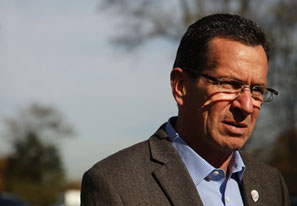
Like other New England states, Connecticut has a vigorous tradition of home rule. But, tired of having to deal with pesky local officials, Governor Dannel Malloy quietly introduced legislation that would create a quasi-public agency—the harmless-sounding Transit Corridor Development Authority. The TCDA would direct so-called transit-oriented development (TOD)—typically mixed-use, high-density construction around rail and bus stops. Malloy’s original bill gave the TCDA broad powers, including the authority to use eminent domain to seize property within a half-mile of transit stops. It also mandated that local officials comply with TCDA decisions. There was so little conversation about the new authority before the bill reached the legislature that even the state’s transportation commissioner hadn’t heard of it.
TOD advocates assume that local authorities are ignoring the potential of transit when they nix high-density development or require developments to provide parking. But local officials see things differently. Draw a half-mile circle around the Metro-North rail stations in Fairfield County, Connecticut—sometimes called the “Gold Coast,” and including towns like Greenwich, New Canaan, and Darien—and you quickly see why officials and residents demanded changes to Malloy’s bill. The land around these stations is some of the most valuable in the country; current development conforms to the quiet, quaint character that attracted many residents. These communities have used their local prerogative to remain suburban. Through the TCDA, Malloy could have changed that, imposing high-density development along the rail line.
The bill has since been amended so that the TCDA would no longer have the power to condemn property. However, the bill would still create the TCDA as a top-down, state-run agency allowing little input or independent oversight. And once the TCDA exists, Malloy would likely try to use it to pursue his aims.
With a few exceptions—including New Jersey, Rhode Island, and Maryland—most transit authorities exist at the local or regional level, reflecting the view that land and transit development is generally best handled by local decision-makers. In its report on TOD, for example, Hawaii emphasized the role of local groups in working to develop state-owned land around transit stops. By contrast, in Connecticut’s amended TCDA bill, all local authorities would have the power to do is designate a transit stop for development. The TCDA board members would then have all decision-making power on how that property is planned and developed. The board could also maintain control over the property indefinitely: the bill gives it express permission to manage property and collect rent.
That the state wanted to turn the power of eminent domain over to a new, quasi-public agency is deeply troubling, especially given the powerful special interests that try to influence government spending on transportation and other property-development projects. Other quasi-public agencies, like the Port Authority of New York and New Jersey, have been plagued by accusations that they lack transparency and accountability.
Why does Connecticut want a statewide transit authority? In part, because Harford has failed to ram through development around existing Metro-North stops. For example, in Stamford—where Malloy was once mayor—the state’s department of transportation chose a preferred developer for a $500 million TOD project nearly two years ago, but the project is mired in a local land-use dispute. Stamford officials have asserted their right to regulate local development—but the new TCDA, if it comes into being, could overrule them if it pleases.
In 2013, the New York metropolitan area’s Regional Plan Association released a report that may have offered the impetus for Malloy’s land grab. “Halfway There” criticizes Connecticut land-use policies in towns and cities along the Metro-North corridor for lacking vision, not always allowing mixed-use development, preventing high-density projects, and requiring too much parking. Malloy’s relationship with the RPA extends beyond mere policy. New York lobbyist Tonio Burgos sits on the RPA board and has hosted fundraisers for the Connecticut governor. RPA chairman Elliot Sander and his colleagues at HAKS Group, an engineering consulting firm, contributed $60,000 to Malloy’s gubernatorial campaign. At least two other RPA board members donated to Malloy through Connecticut’s state Democratic Party.
Malloy is currently traipsing around the country trying to capture national attention, so perhaps he’ll be too busy to muscle the TCDA bill through the legislature. The bill’s fate will hinge on whether Malloy can convince enough legislators that he needs this power to create the kind of change he believes Connecticut needs—or state lawmakers will listen to their worried constituents instead.



